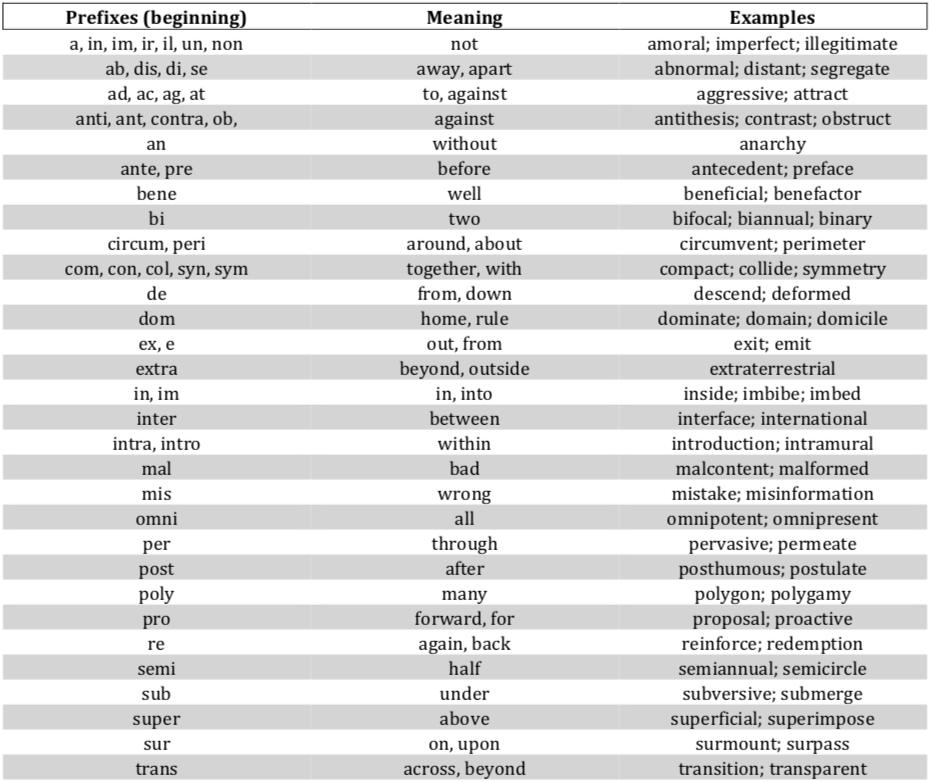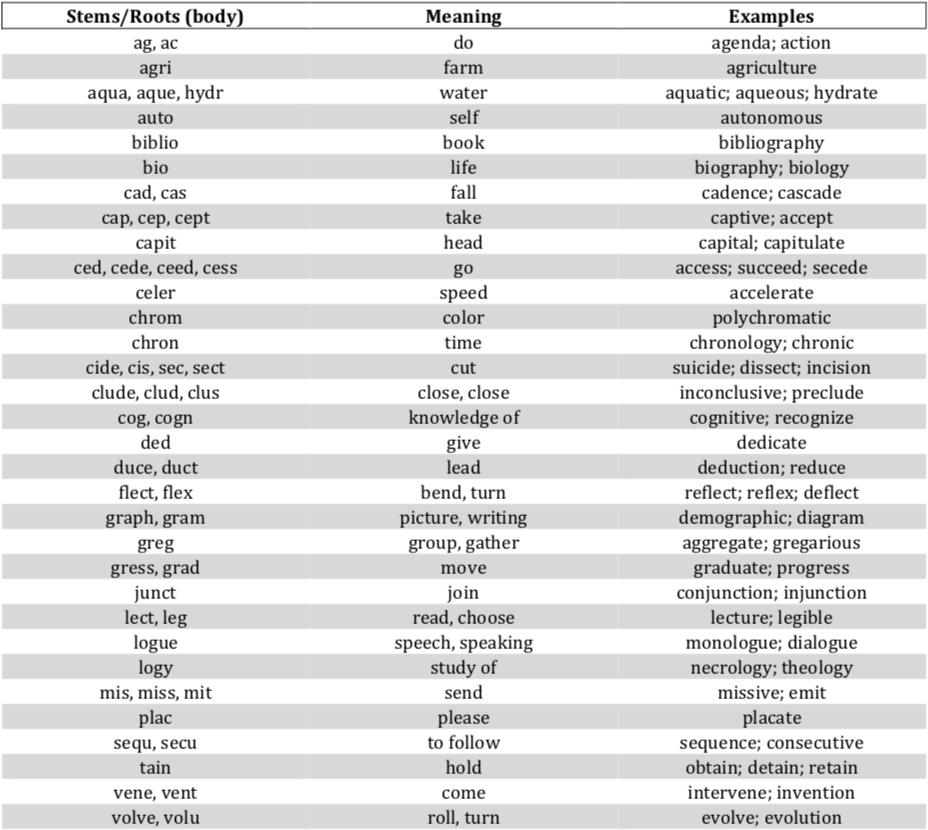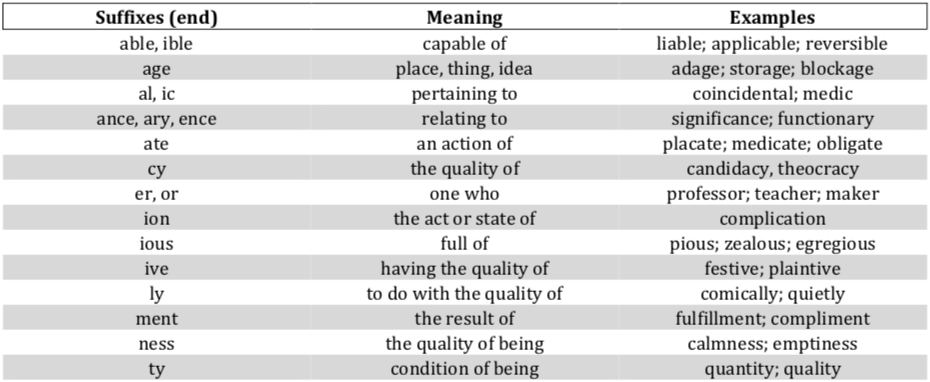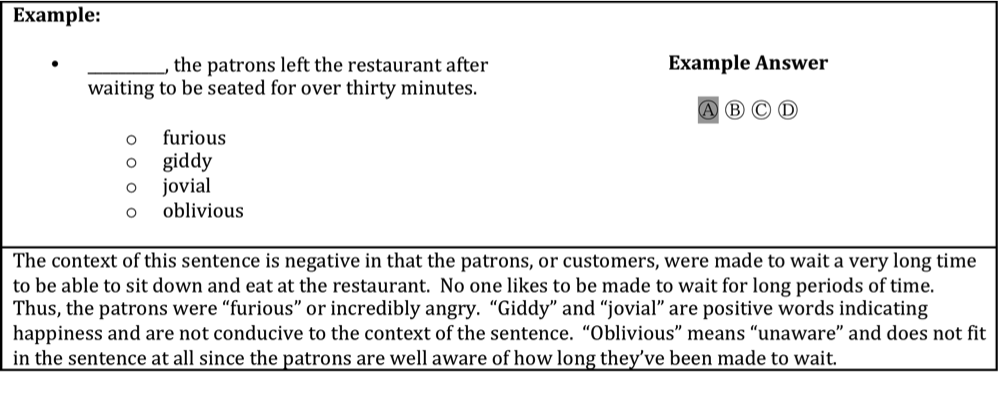
The ISEE Verbal Reasoning test is the first of four sections in this private school admissions exam. Students who excel on the ISEE are set up for success on their private school applications, so taking the time to prepare for each section in advance is worth the effort!
The ISEE (Independent School Entrance Exam, generally pronounced “i-see”) is a peer-normed, standardized test most commonly taken by students applying to middle and high school (some students take the test to get into earlier grades). To evaluate students’ reading and math skills, it consists of two ELA sections and two math sections:
| ISEE Section | Time | Number of Questions |
|---|---|---|
| Verbal Reasoning | 20 Minutes | 40 Questions (34 LL) |
| Quantitative Reasoning | 35 Minutes | 37 Questions (38 LL) |
| Break | 5-10 Minutes | |
| Reading Comprehension | 35 Minutes (25 LL) | 36 Questions (25 LL) |
| Mathematics Achievement | 40 Minutes (30 LL) | 47 Questions (30 LL) |
| Break | 5-10 Minutes | |
| Essay | 30 Minutes | |
| Total | ~2 Hours 40 Minutes (2:20 LL) | 160 + Essay (127 + Essay LL) |
As we mentioned, Verbal Reasoning is the very first section of all levels of the ISEE (lower, middle, and upper). It’s also the fastest section, allotting 20 minutes for test-takers to answer 40 questions about vocabulary words. In this deep-dive into the Verbal Reasoning section of the ISEE, we describe the types of questions you’ll encounter, strategies for solving those questions, and the most effective methods to strengthen your vocabulary skills for this exam.
Types of Verbal Reasoning Questions
There are two types of questions on the ISEE Verbal Reasoning section: Synonyms and Sentence Completions. These questions test your vocabulary knowledge and your ability to apply it. Each level of the ISEE tests students on a corresponding vocabulary level; Upper Level ISEE–takers will encounter more advanced words than those taking the Middle Level test.
Synonym Questions
The ISEE Verbal Reasoning Synonym questions prompt you to match a synonymous answer choice with the provided word, testing you on your vocabulary knowledge. You’re expected to know the definition of the word in all capital letters as well as the definition of each answer choice:

How to Approach Synonym Questions
With 20 capitalized words, each paired with 4 answer choices, you must potentially define 100 vocabulary words. The words are presented alone, so you won’t have any context to help you find its meaning. In addition, the test will likely include several words that you won’t encounter in the vocabulary lists you’ll use to study.
Having a systematic approach to answer each Synonyms question will help you investigate each word, using what you do know to make a strong educated guess on unfamiliar vocabulary.
| Synonyms: 5-Step Approach | |||
|---|---|---|---|
| Step 1 | Do I know the DEFINITION of the word? | Create your own synonyms, then compare to the answer choices. | |
| Step 2 | Have I seen/heard the word in any CONTEXT? | Determine how the word was written/spoken in your memory. | |
| Step 3 | Will WORD PARTS help me? | Use prefixes, suffixes, and root words to analyze the word’s meaning. | |
| Step 4 | Is the word POSITIVE or NEGATIVE? | Positive can mean having a good or additive element to the word. | Negative can mean having a bad or subtractive element to the word. |
| Step 5 | Can I make an EDUCATED GUESS with what I know? | Eliminate answer choices that have the same meaning or are obvious antonyms. | If you get stuck, SKIP IT! Circle the question in the test booklet and answer it later. |
| If you’re still unsure, DO NOT leave it blank. Choose the answer that makes the most sense. | |||
Use this chart as a reference as you do practice questions for the ISEE to become familiar with this process. The ISEE does not penalize wrong answers, so make an educated guess when necessary. Here’s an example of the approach for finding the synonym of the word “PROLIFERATE”:
| DEFINITION |
Following the approach above, decide if you know the word. If you don’t, then SKIP IT!
PROLIFERATE means to rapidly increase in numbers. So, we generate the word increase as our synonym. We can then see that answer choice C is multiply, a synonym for increase. |
PROLIFERATE ➔ multiply A. obstruct |
| CONTEXT |
If you don’t know the word’s definition, you can use context clues to help. Perhaps you’ve heard it somewhere or read it in a book. Maybe your science textbook mentioned the proliferation of a certain species due to a larger food supply.
With that, you can understand that “proliferate” has to do with increasing or growing larger. |
PROLIFERATE ➔ multiply A. obstruct “I’ve heard this word used to describe a species growing in numbers… That means to multiply!” |
| WORD PARTS |
If you don’t remember hearing this word before, you can break it down into word parts.
These parts can paint you a picture of what the word could mean—even if you can’t break up the whole word, it could give you a strong hint. |
1. PRO-: (prefix) forward or for something forward + action of + producing The answer choice closest to this meaning is multiply! |
| POSITIVE VS. NEGATIVE |
If knowledge, context, and word parts fail you, you can eliminate some answer choices by determining whether the word is positive (good, helpful, more) or negative (bad, harmful, less).
PROLIFERATE contains “pro-”, which you’ve heard used to mean a benefit (like “pro vs. con”) or movement forward (like “progress”). Thus, PROLIFERATE seems positive. |
Answer choices A and D seem negative. PROLIFERATE ➔ multiply A. obstruct Thus, you’re left with “perceive” and “multiply”—decide which one best matches being a benefit or movement forward. |
Remember that a positive word isn’t necessarily “good”, and a negative word isn’t necessarily “bad”. Consider this more like positive and negative numbers—a positive word can mean an addition, movement forward, or growth, and a negative word can mean a reduction of some kind or a movement backwards.
Basically, a word is positive if it moves forward or toward something, adds or increases, is the primary focus of the sentence, or compliments something. A word is negative if it moves back or away from something, takes away or decreases, is the secondary focus of the sentence, or contrasts something.
Word Parts: Affixes and Roots
Even though math and ELA are often considered opposites, there are more similarities than you think. Words are made up of parts, sounds that have their own meanings—when these word parts are combined, their meanings are added together like an equation.
Roots are the basic building blocks of words. All words contain a root, but many also contain one or more affixes. Affixes attach to a word to alter its meaning or create a new word. Prefixes attach to the beginning of a word, while suffixes attach to the end. (As a result, suffixes are also able to change the grammar of a word by altering the tense of a verb and the plurality of a noun.)
For example: The word “amorphous” contains the prefix “a-”, meaning not; the stem “morph”, meaning shape; and the suffix “-ous”, which means possessing or full of. Thus, the word parts show that “amorphous” means possessing no shape. (Be careful not to mix up the stem “morph” with the actual word “morph”, which means to change or transform. You might then confuse the meaning of “amorphous” to be no change, which is very different from the real definition.)
Becoming familiar with common word parts and their meanings will help you work through the composition of an unknown word and piece together its definition. These tables list some of the most popular affixes and stems, together with examples—study and reference them as you work practice vocabulary questions.
Table of Common Prefixes

Table of Common Stems/Roots

Table of Common Suffixes

Sentence Completion Questions
The ISEE Verbal Reasoning Sentence Completion questions prompt you to fill in the blank in a given sentence with an applicable vocabulary word. These questions test you on your ability to apply vocabulary knowledge—you’re expected to know the definition of each answer choice as well as the composition of the sentence and how a word could fit within that structure.

Understanding the Design of a Sentence
While Synonym questions focus on your vocabulary knowledge and ability to decipher the meaning of new words, Sentence Completion questions take it a step further by asking you to apply that knowledge. Each question will contain a complete sentence with one or two blanks (two-blank sentences are ISEE Upper Level only). You must choose from the answer choices which word or pair of words best matches the context of the sentence.
The context of a sentence is the particular way it conveys a thought, similar to positive and negative words like we discussed above. A sentence has a positive context if it conveys beneficial or additive situation or indicates movement towards something, while it has a negative context if it conveys a harmful situation, something decreasing, or movement away from something. For example:
“Sheila earned promotion after promotion due to her astounding work ethic.”
-
- If you earn a promotion, you’ve shown the company you are capable of more responsibility (and worth higher pay)—a promotion is a good thing.
- So, the context of the entire sentence is POSITIVE.
- Thus, we can determine “astounding” is also positive (astounding = amazing).
“Jordan gave a dejected sigh after finding yet another milk carton left in the bread aisle by a customer.”
-
- It’s likely that the milk went bad because it is meant to be refrigerated—this means that it is completely wasted food, the grocery store lost product, and Jordan must clean it up.
- So, the context of the sentence is NEGATIVE.
- Thus, we can determine that “dejected” is also negative (dejected = very unhappy).
Many sentences will kick it up a notch by changing their context, starting negative then ending positive (or vice-versa). For example:
“Despite being a dexterous gymnast, Paul’s scores at the tournament were abysmal.”
-
- The key word in this sentence is “despite”—it signals that the first part of the sentence (prior to the comma) is the opposite context from the second part.
- Paul’s gymnastic skills are highlighted at the beginning; so, “despite” indicates that the last part refers to scoring poorly at the tournament. (Starts POSITIVE, finishes NEGATIVE.)
- We can determine that “dexterous” is POSITIVE while “abysmal” is NEGATIVE. (dexterous = skilled; abysmal = awful)
“Although Lily had been reticent around other people in the past, she grew into a gregarious individual after taking up and competing in volleyball.”
-
- “Although” is the key word in this sentence, signaling the change in tone/context between the first and second clauses.
- Lily took up volleyball in the second portion of the sentence, a team oriented sport. Communication plays a heavy role in these types of sports, which means there must be a relationship between “gregarious” and the nature of volleyball.
- If the second half refers to communication, then the first half must refer to Lilly’s lack of communication. (The context of the sentence starts NEGATIVE then finishes POSITIVE.)
- We can determine that “reticent” is NEGATIVE while “gregarious is POSITIVE. (reticent = quietly reserved; gregarious = sociable)
Sentences that change context can be difficult to decipher, but understanding the logical relationships that certain words create can help:
| Logical Relationship | Key Words / Clues | Determining Context |
|---|---|---|
|
Contrasting Ideas
"Even though the plane was late taking off, we arrived at our destination right on time." |
although, but, despite, even though, however, instead of, nonetheless, not, on the contrary, rather, yet | The key word signals a change in tone will occur. The sentence will start out one way then finish another. |
|
Complementary Ideas
"The hurricane destroyed homes all along the coastline; furthermore, it knocked down power lines, leaving millions without electricity." |
additionally, also, and, because, besides, consequently, for, furthermore, likewise, moreover, similarly | The key word signals the tone of the first portion of the sentence will match the tone of the second portion. |
|
Cause and Effect
"Because he sacrificed his life in the defense of the fort, his comrades survived the battle." |
accordingly, because, consequently, for, hence, in order to, since, so, therefore, thus | The key word signals the tone of the first portion may differ from the second portion or match it. The tone starts negative then finishes positive in the example. |
|
Definition or Explanation
"Maria was extremely unselfish, willing to share even her most prized possessions with her friends." |
comma, semicolon, or colon | The punctuation signals the second portion of the sentence we define or explain the first portion of the sentence and maintain context. |
How to Approach Sentence Completion Questions
Having a systematic approach to answer each Sentence Completions question will help you investigate each sentence thoroughly, helping you understand the context to define the missing word.
Note: Students who read slowly should allot themselves more time for this portion of the Verbal Reasoning section (such as 5 minutes for Synonyms questions and 15 minutes for Sentence Completion questions).
For an example of how to solve an ISEE Upper Level two-blank sentence:
1. The lawyer __________ his opponent when they attempted to use __________ evidence to question the witness.
A. bartered — complacent
B. consoled — relevant
C. lambasted — irrelevant
D. praised — tangible
| CONTEXTUAL STRUCTURE | When you read the sentence, does it feel like a positive or negative statement? |
The sentence is negative throughout, as the lawyers are competing against each other in court.
Lambasted and irrelevant are negative words. |
| OWN WORDS | Once you’ve figured out the contextual structure of the sentence, come up with your own words to fit in the blanks. |
The lawyer attacked his opponent when they attempted to use bad evidence to question the witness.
|
| DEFINITION | Determine if you know the definitions of the answer choices. If you don’t, SKIP IT! |
Attacked matches lambasted (lambasted = criticized).
Bad matches irrelevant (irrelevant = doesn’t work). |
| WORD PARTS or CONTEXT CLUES | When you return to the question, use the strategies above (under Synonyms) about word parts and context clues to determine the answers’ definitions. Then, place answers in the blanks to see what works. |
|
How to Study ISEE Vocabulary
There are a few different methods you should use to improve your vocabulary skills, especially ahead of a test like the ISEE’s Verbal Reasoning section. These are best used in tandem; that is, set aside time for each type of practice throughout the week!
1. Study Vocabulary Lists
The most straightforward way to expand your vocabulary knowledge is to study vocabulary lists! These are collections of words you’re likely to see on the ISEE Verbal Reasoning test.
Your vocabulary studies should be less about memorization and more about exposure to new vocabulary and recognizing the connection between words (especially because of the Synonyms questions). We recommend that you set a goal of studying and defining 50 words each week. We’ve published a full ISEE vocabulary list for each level of the exam that you can use to study:
- ISEE Lower Level Vocabulary List (650 words)
- ISEE Middle Level Vocabulary List (1000 words)
- ISEE Upper Level Vocabulary List (1200 words)
Each of the above lists is made up of several smaller lists, portioned into groups of 30 words that you can use each time you practice. In order to fully grasp its meaning in preparation for the ISEE, we recommend the following study process for each vocabulary term:
- Define the word.
- Identify the etymology of the word. (A word’s etymology is its origin, which will teach you its word parts.)
- Identify 5 synonyms for each word. (Using a thesaurus.)
As you study each word, pay attention to the context it is used in within example sentences. (For an example of context, “aroma” and “stench” both refer to a smell, but “aroma” is used in positive contexts while “stench” is negative.) To supplement your study notes for quick review sessions, you can even make flashcards to quiz your knowledge and even practice physically grouping synonyms.
2. Take Practice Questions and Benchmarks
Like you should do for all future tests, study using questions designed for the exam. By practicing with questions that resemble what you’ll encounter on the ISEE Verbal Reasoning, you’ll become comfortable with solving those types of problems. Use the strategies we’ve described above as you practice, and you’ll remember what to do come test day.
In addition to regularly practicing with test-specific questions, you should take at least one benchmark for your ISEE ahead of test day. Not only will this help you gauge your current skills and see how much you need to improve, but taking multiple practice exams is proven to help improve test-taking performance.
3. Read in Your Free Time!
This last method to improve your vocabulary is a hobby that will improve your ELA skills while keeping you entertained: reading! By simply reading more, you’ll come across new words through an enthralling story. The sentence a vocabulary word appears in can give you some context to help you understand its meaning, but you should always take this further by studying the word.
Take the time to do the vocabulary study process above for the unknown vocabulary you come across (defining the word, identifying its etymology, and finding five synonyms). Each word that you study with this process counts as part of the 50 words you study each week!
If you’re having trouble concentrating on your book or struggling to even start reading, you may need to find a different read. One of the reasons many students become reluctant readers is that they aren’t interested in any of the books they read. Read articles or books about your interests, check out popular novels of different genres from the library, and find suggestions online or from friends.
Reading Recommendations from Piqosity:
- 5th Grade Books to Improve Vocabulary
- Books by Black Authors for Each Grade Level
- Adventurous Books for Summer Reading for Grades 4-12
- Books to Increase Vocabulary for Each Grade
Most importantly: challenge yourself by reading at a slightly higher level than your own, and make sure you are reading with intention. That is, engage with the text through annotations or mental notes to help you stay focused and truly comprehend it. This will help you learn unknown words and practice the skills you’ll need for the ISEE Reading Comprehension section.
Personalized Online ISEE Prep
Use these ISEE Verbal Reasoning tips and strategies to map out your study plan for this section of the test! Remember that taking multiple practice tests before your ISEE test day (and retaking it once you learn from your first attempt) will grant you the most opportunities to learn from your mistakes and give a strong performance. Whichever level of the ISEE you’re taking, Piqosity can help you prepare to excel on all sections of the test.
Along with our full-length, online ELA and Math courses for grades 6-11, we offer a market-leading ISEE prep course, which includes detailed topic lessons, hundreds of questions, and 12 full-length practice tests, together with personalized practice software that identifies your weaknesses and helps you study effectively. Sign up for an account and you can take a No-Cost Mini Diagnostic ISEE test—no credit card required!



Leave A Comment